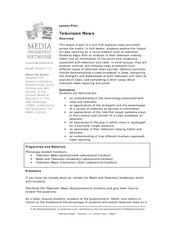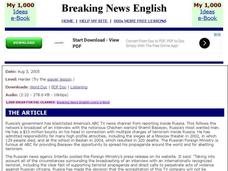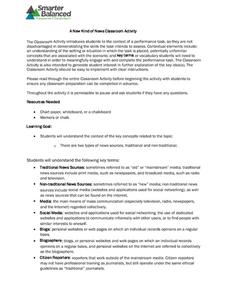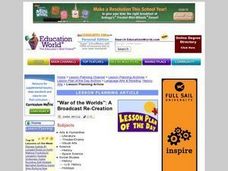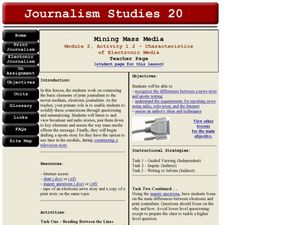Curated OER
Television News
Different media sources portray news in a variety of ways. In groups of three, learners look at different news sources, bringing in all the findings the next day. Three handouts help scholars compare sources, define specific terms used...
Brown University
Analyzing the News
With so many ways to follow the news today, it is imperative to think critically about the sources of information we are turning to. Here is a fantastic graphic organizer that will help your learners develop the skills to properly...
Curated OER
Television Newscasts
When we watch news broadcasts on television, we receive a much more visual perspective than when we read the newspaper. How do sets, clothing, and music contribute to our understanding of the story? Compare American and Canadian news...
Curated OER
Information Overload: Looking at News
How do events reported in mainstream newspapers, on television news, blog posts, and social network sites differ? Ask your class to investigate the way the same news item is presented in the many information sources available. Groups...
PBS
Broadcast News
Just because a story is on the news doesn't mean it's being presented fairly. Analyze news broadcasts with a lesson focused on evaluating television journalism. At home, kids watch a news show and note the stories presented, including...
Curated OER
Radio News
Part of a larger unit from the Media Awareness Network on media literacy, this particular lesson plan focuses on the medium of news radio. Small groups participate in discussions on their radio listening habits as well as the...
Curated OER
Breaking News English: TV News about Russia
In this TV News about Russia learning exercise, students read the article, answer true and false questions, complete synonym matching, complete phrase matching, complete a gap fill, answer short answer questions, answer discussion...
Curated OER
News
How does broadcast news differ from accounts reported in newspapers? On the radio? Through the Internet? Middle schoolers discuss the news and speak about the differences between news in print and broadcast news. Given a list of six...
Curated OER
Edward R. Murrow: This Reporter
What would Edward R. Murrow think of today’s news broadcasts? Learners examine the work of the first public television newscaster and his commitment to researched, accurate reporting. The eight-day study concludes with investigators...
Curated OER
News Coverage
Students compare and contrast methods of media coverage. In this media awareness lesson, students keep track of news regarding a world or national issue for the period of 1 week. Students collaborate to describe the type of coverage...
Curated OER
Conversation Lesson: News
In this conversation lesson worksheet, 7th graders use context clues to get the meaning of 8 words, then select 6 news stories from a list of 12 and explain why they would choose those for an evening TV news broadcast.
Curated OER
The World in 22 Minutes: Constructing a TV News Lineup
Students examine several newspapers to compare front pages, headlines, and photographs, experience role of news editor, define and discuss factors that go into news judgements, and arrange twenty-two minute news broadcast by selecting...
Curated OER
Using a Graphic Organizer to Critically Observe Televised News Broadcasts
Students compare two television news broadcasts. They discuss how to organize information when comparing two objects and read and discuss two books to create a Venn diagram to compare both books. After creating the diagram, they view...
Smarter Balanced
A New Kind of News
Newspapers and broadcast news. Social media, blogs, and blogospheres. Class members generate a list of news sources they use to get information about events. The big idea here is to introduce the necessary vocabulary and to establish a...
Curated OER
Digesting the News
Students explore the editorial concepts, site designs and business models of online news digests. They propose detailed plans for Web sites that demonstrate their own areas of expertise.
Curated OER
Staying Informed
Students identify the various ways the American public can stay informed on the news. In groups, they brainstorm reasons why the public should not stick to one source for their news. They use this information to examine their own current...
Curated OER
Using News Broadcasts in Japan and the U.S as Cultural Lenses
High schoolers view archives of news broadcasts in order to create a context of cultural understanding. They compare and contrast the news broadcasts in Japan and the United States.
Curated OER
Watching the Clock: An activity to build media-savvy students
Students analyze time constraints on broadcast news. They apply data collecting and data display skills. They identify the difference between news progams and the evening news.
Curated OER
Shaping the News
Students explore television journalism. In this journalism activity, students discuss the attributes of television broadcasting. Students then review their journalism code of ethics and then conduct research for stories that have a moral...
Curated OER
VOLC TV News Team
Students produce a 5 minute internet news cast about an active volcano
Curated OER
"War of the Worlds": A Broadcast Re-Creation
Why did Orson Welles' 1938 Broadcast of a adaptation of H.G. Wells' The War of the Worlds cause such a panic? To answer this question, class members listen to the original broadcast and research the panic that resulted. They then engage...
Curated OER
You Are There: Television News Reports on Apartheid
Students, in groups, research apartheid and its effects on South Africa. They present their information to the class.
Curated OER
How Media Shapes Perception
Students explain the impact that the media may have in shaping their intellectual and emotional responses to current events. They examine broadcast and Web-based news sites to find subtexts through the use of language, audio, and visual...
Curated OER
Mining Mass Media
Students take a closer look at the attributes of electronic media. In this journalism lesson plan, students compare and contrast electronic and print versions of the same news stories. Students then write their one broadcast news stories.


